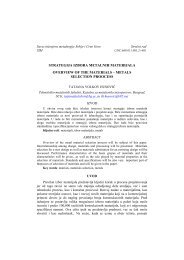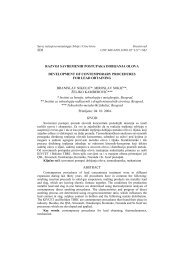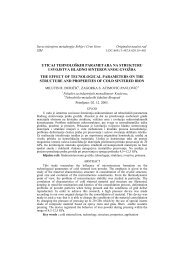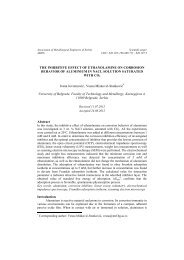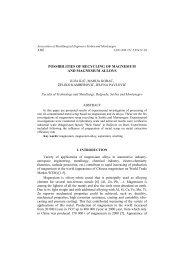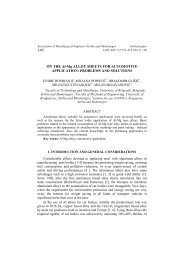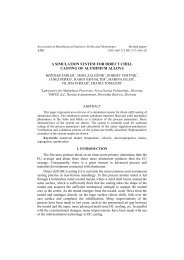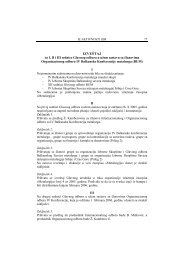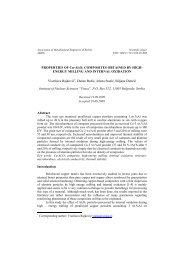ferrous metallurgy center of the brnjica cultural group - CEON
ferrous metallurgy center of the brnjica cultural group - CEON
ferrous metallurgy center of the brnjica cultural group - CEON
Create successful ePaper yourself
Turn your PDF publications into a flip-book with our unique Google optimized e-Paper software.
FERROUS METALLURGY CENTER OF THE BRNJICA CULTURAL ... 109<br />
The context (grave finds) <strong>of</strong> individual artefacts point out that <strong>the</strong> <strong>ferrous</strong><br />
products were exceptionally appreciated during <strong>the</strong> 14 th –13 th centuries BC in <strong>the</strong><br />
Pomoravlje region (along <strong>the</strong> Morava rivers), not only as expensive products but as<br />
objects <strong>of</strong> definite symbolic meaning.<br />
Hisar in Leskovac was <strong>the</strong> only settlement within <strong>the</strong> central Balkan region<br />
from <strong>the</strong> period <strong>of</strong> <strong>the</strong> 14 th –13 th centuries BC with a fortification – an acropolis <strong>of</strong><br />
several hectares <strong>of</strong> land. Its location (at <strong>the</strong> crossing points <strong>of</strong> roads leading along<br />
<strong>the</strong> Jablanica and Veternica rivers’ valleys and along <strong>the</strong> Morava river valley), its<br />
size (<strong>of</strong> several hectares), its continuity (14 th –13 th centuries BC), permanent<br />
development, specialized features <strong>of</strong> individual parts <strong>of</strong> <strong>the</strong> settlement (acropolis,<br />
metallurgic <strong>center</strong>, bone processing <strong>center</strong>, representative architecture (habitations<br />
decorated in Mycenaean style plastics), variety <strong>of</strong> ceramics (diverse forms,<br />
extraordinary quality, richness <strong>of</strong> decoration, Mycenaean style imitations), – all <strong>of</strong><br />
<strong>the</strong>se confirm that <strong>the</strong> settlement at <strong>the</strong> Hisar location in Leskovac was <strong>the</strong> most<br />
representative one and undoubtedly <strong>the</strong> main settlement <strong>of</strong> <strong>the</strong> Brnjica community,<br />
<strong>the</strong> largest and <strong>the</strong> only one artificially fortified settlement within <strong>the</strong> whole central<br />
Balkan region during <strong>the</strong> last centuries <strong>of</strong> <strong>the</strong> second millennium BC.<br />
The settlement, being <strong>the</strong> largest within <strong>the</strong> whole central Balkan region, as<br />
already emphasized, distinguishes itself by two characteristics. It has its fortification<br />
– acropolis, protected by a moat and a rampart, its bronze and iron metallurgic and<br />
handicrafts <strong>center</strong>s and a separate bone processing <strong>center</strong>. In all cultures and periods<br />
<strong>of</strong> time, metallurgic <strong>center</strong>s, particularly <strong>the</strong> iron ones, were under <strong>the</strong> protection <strong>of</strong><br />
fortified palaces i.e. <strong>of</strong> fortifications.<br />
The earliest iron <strong>metallurgy</strong> (in <strong>the</strong> second half <strong>of</strong> <strong>the</strong> second millennium BC)<br />
in <strong>the</strong> Middle East was carried out explicitly under <strong>the</strong> auspices <strong>of</strong> <strong>the</strong> capital <strong>of</strong> <strong>the</strong><br />
state and <strong>the</strong> ruling palace [11]. The Hisar settlement in Leskovac from <strong>the</strong> second<br />
half <strong>of</strong> <strong>the</strong> second millennium BC reproduces <strong>the</strong> same pattern.<br />
It might be supposed that knowledge <strong>of</strong> iron <strong>metallurgy</strong> arrived to Pomoravlje<br />
from <strong>the</strong> Mycenaean area, <strong>the</strong> same as <strong>the</strong> influences manifested in <strong>the</strong> architectural<br />
plastics (to be found at Hisar) as well as in painted ceramics. The Mycenaean<br />
civilization reached its culmination in <strong>the</strong> 14 th –13 th centuries BC, greatly because <strong>of</strong><br />
<strong>the</strong> monopoly both <strong>of</strong> production and distribution <strong>of</strong> bronze artefacts across <strong>the</strong><br />
significant part <strong>of</strong> <strong>the</strong> Mediterranean. On Mycenaean territory were found <strong>ferrous</strong><br />
artefacts, but <strong>the</strong>re is no pro<strong>of</strong> <strong>of</strong> local <strong>metallurgy</strong> <strong>of</strong> <strong>the</strong> metal, which makes it<br />
certain that <strong>the</strong>se <strong>ferrous</strong> artefacts were imported from <strong>the</strong> Middle East (<strong>the</strong> same as<br />
in Egypt) [12]. It seems, however, that <strong>the</strong> <strong>ferrous</strong> artefacts stemming from <strong>the</strong><br />
Mycenaean soil are younger as compared to <strong>the</strong> <strong>ferrous</strong> artefacts belonging to <strong>the</strong><br />
Brnjica <strong>cultural</strong> <strong>group</strong> from Pomoravlje. Moreover, it seems that <strong>the</strong> Mycenaean<br />
interest for some communities in Pomoravlje, such as <strong>the</strong> one belonging to <strong>the</strong><br />
settlement in Leskovac, proved by architectural plastics and painted ceramics – was<br />
at least partly motivated by possibility to acquire iron. Even if <strong>the</strong> Mycenaean<br />
community had <strong>the</strong> knowledge to produce iron, it was much easier for <strong>the</strong>m to get it<br />
through barter from outside than to produce it on its own soil because <strong>of</strong> <strong>the</strong><br />
energetic shortage (lack <strong>of</strong> wood) <strong>of</strong> <strong>the</strong> civilization from <strong>the</strong> south <strong>of</strong> <strong>the</strong> Balkan<br />
Peninsula.<br />
There are reliable pro<strong>of</strong>s <strong>of</strong> iron utilization by all <strong>the</strong> central Balkan<br />
communities as well as that <strong>the</strong> Brnjice community, as already mentioned, mastered<br />
<strong>the</strong> iron <strong>metallurgy</strong> and handicrafts based on this metal in its early stage (ca. 1350<br />
BC) [13]. Moreover, all <strong>ferrous</strong> artefacts found in <strong>the</strong> central Balkan region come




